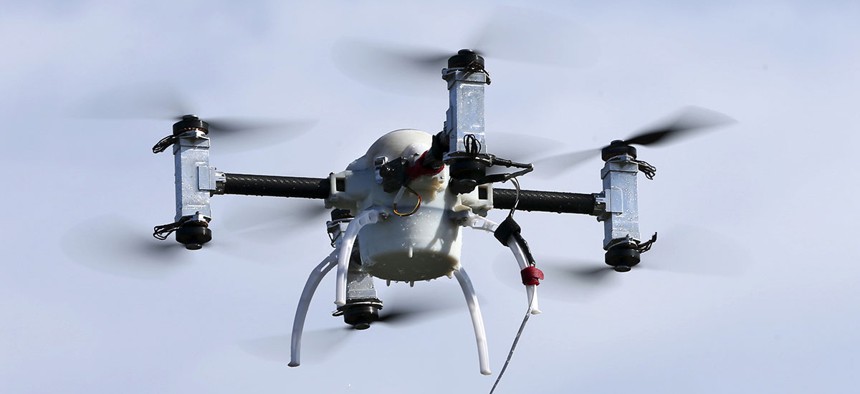Drones Flying By Airports Coming Soon(ish)

A small drone with eight rotors, capable of working underwater, flies during a demonstration Wednesday, June 22, 2016, in Lower Township, N.J. Mel Evans/AP
Current FAA regulations prohibit drones from flying within 5 miles of an airport without notifying air traffic control.
The Federal Aviation Administration expects to deliver a prototype of an automated flight certification system this year that will allow drones to fly in controlled airspace, the agency administrator said.
“This sets up what is really true integration of unmanned aircraft working in the same space as traditional manned aircraft,” Administrator Michael Huerta said May 3 at Bloomberg Government’s Next Tech event in Washington.
Under current FAA regulations, drone pilots only can operate in space up to 400 feet and their vehicles must remain in line of sight. They’re prohibited from flying over people, which rules out most urban areas, and from flying within 5 miles of an airport without notifying air traffic control.
» Get the best federal technology news and ideas delivered right to your inbox. Sign up here.
And people underestimate how many airports there are. Strict interpretation of the 5-mile rule means drone operators in the “whole state of New Jersey” can’t fly with without waivers, Huerta said. The current waiver process takes about 90 days and requires operators file flight plans that are then evaluated and reviewed. FAA’s automated system aims to speed that up considerably.
The Low Altitude Authorization and Notification Capability, or LAANC, will provide maps, a third-party application, and instant answer for flight plans. If approved, Huerta said the system also will automatically notify air traffic control.
FAA air traffic control historically relies on a manual process: Pilots call into air traffic control for the 50,000 flights in controlled airspace that happen each day. It took 100 years to get up to the 320,000 or so planes today, Huerta said. Compare that to the more than 800,000 drones the agency registered in a year.
The sheer numbers mean FAA and its partners NASA and various technology companies continue to look at how automation and “self-separation” play roles in the UAS Traffic Management system expected sometime in 2019.
But FAA isn’t going to flip a switch that allows drones to fly freely in the sky. Instead, Huerta said the agency aims for regular progress in “staged integration,” pressing for the highest level of safety and issue new rules when it’s satisfied with the answers.
The agency continues to work with industry partners on technological solutions to some of its pressing concerns. For example, before the agency allows operators to fly drones beyond line of sight, it needs to be satisfied sense-and-avoid technology can effectively avoid collisions.
And what happens if a drone crashes into a crowd at a concert or a random (but unfortunate) person hanging out in a park?
The agency recently released a report on drone/human collisions, some of which could be mitigated by encouraging manufacturers to use softer materials, shielded blades and software that creates a controlled descent.
“If we wanted to accept no risk, we wouldn’t allow them at all,” Huerta said.
NEXT STORY: The Self-Driving Dilemma



